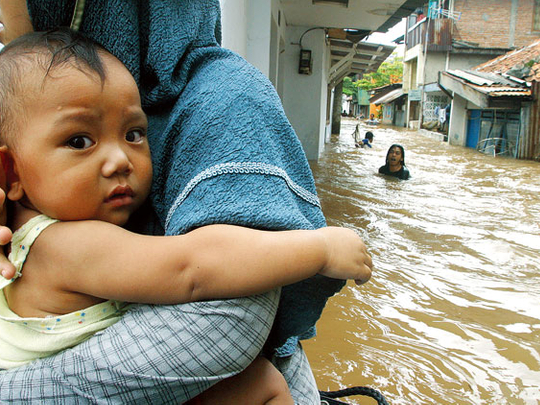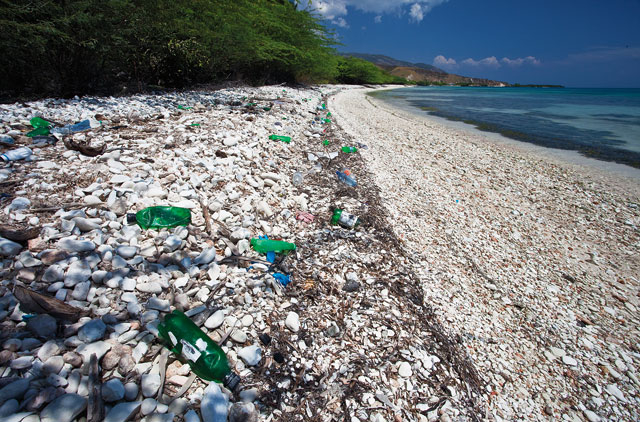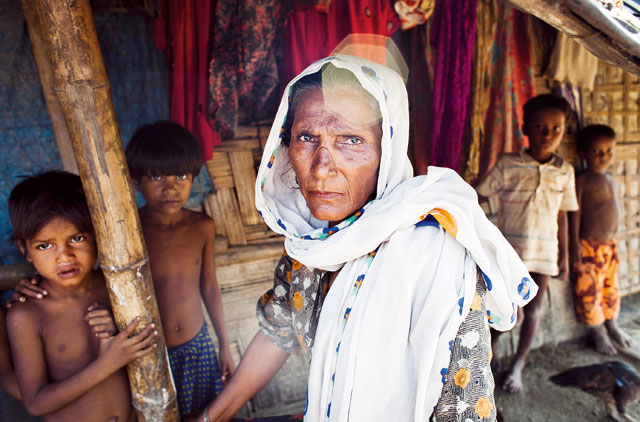
Activists and scientists have long warned that our overstretched planet is reaching an environmental tipping point after which humanity will face cataclysmic consequences. Natural resources are stretched, climate change is altering the planet’s weather patterns and the rising human population will eventually become unsustainable. The time to act is now. Thankfully international governments are taking notice, but these issues are already having a profound impact on the world. Here, Friday takes a look at the problems facing the world and asks what can be done to solve them.
Rising sea levels
Over the past century the average global sea level has risen by between ten and 20 centimetres, and that rate is increasing. The cause is global warming. Burning fossil fuels and other human and natural activities release heat-trapping gases into the atmosphere. The oceans absorb about 80 per cent of this additional heat. Heated water expands and fuels the melting of glaciers and polar ice caps, meaning there is more water in the oceans. When sea levels rise rapidly, even a small increase can have devastating effects on coastal ecosystems and human populations. Hundreds of millions of people live in areas that will become increasingly vulnerable to flooding. Higher sea levels have forced people to abandon their homes and relocate. Eventually, low-lying islands could be submerged completely.
Earlier this year a survey of glaciologists revealed that many feared they had seriously underestimated the potential for melting ice sheets to contribute to a catastrophic increase in sea levels in the coming decades. Some scientists estimate an increase of one metre or more by 2100.
But with uncertainty about its magnitude, it is difficult to create a solution for the problem. Increased investment in flood defences would protect coastal regions in the short term, but ultimately only a fundamental reduction in greenhouse-gas emissions would stop the ocean levels from rising, preventing the floods.
Pollution
The UAE is no stranger to pollution. Last year the eastern shores were hit by a slick of oil caused by the dumping of crude and sludge by tankers and other vessels in violation of local and international laws. The pollution killed a large number of fish.
In 2010 the UAE was named one of the world’s largest producers of waste. That year, Abu Dhabi’s average annual per capita household waste stood at 730 kilograms, while Dubai followed closely at 725 kilograms, according to a report by Al Ghurair University. The figures were almost 30 per cent more than the averages of Organisation for Economic Cooperation and Development (OECD) member states.
Pesticides, herbicides, chemical fertilisers, detergents, oil, sewage, plastics and other solids are choking the oceans. Many of these pollutants collect on the ocean floor where they are consumed by small marine organisms and are introduced into the global food chain.
Nitrogen-rich fertilisers wash into oceans and lakes and spawn massive blooms of algae that rob the water of oxygen and create dead zones for plant and animal life. In some areas ocean currents compact decomposing plastic items and other rubbish into gigantic, swirling rubbish islands. One in the North Pacific, known as the Great Pacific Garbage Patch, is estimated to be the size of Texas.
However, pollutants in the atmosphere are the main factor contributing to global warming. Carbon dioxide, mainly through burning fossil fuels, locks in heat. Methane is another potent greenhouse gas, and actually traps heat in the earth’s atmosphere at a higher rate than carbon dioxide. It is produced by a number of human sources including coal mining, livestock farming and landfills.
Recycling efforts, carbon-capture technology and investment in alternative energy sources will all need to be employed to reduce the catastrophic effects pollutants are having on the planet.
Food shortages
Last year was a disastrous year for global food production. Heat waves, floods and droughts led to harvest failures in many food-producing regions of the world including the USA and Ukraine. Levels of production were so badly hit that reserves are at a worryingly low level. The UN Food and Agriculture Organisation (FAO) estimates that today global food reserves would only last 74 days if food production was curtailed. The real worry now is that another year of adverse weather will further reduce the amount of food available.
Abdul Reza Abbassian, a senior grain analyst with the FAO, says, “We’ve not been producing as much as we are consuming. That is why stocks are being run down. Supplies are now very tight across the world and reserves are at a very low level.”
The shortages are driving up prices of staples such as wheat and rice, and Oxfam has warned that prices could double in the next 20 years, regularly sparking the kind of food riots seen in 2008 in Haiti and in parts of Africa.
Some scientists are hopeful that the answer will be provided by introducing more drought-resistant, high-yield genetically modified (GM) crops. They are also developing other novel ways to boost production. Last year Dutch scientists successfully created strips of muscle tissue in a laboratory using stem cells. The technique could become a more efficient way of ‘growing’ meat.
Water stress
The world is running out of clean drinking water. Resources are overexploited by growing populations. Pollution, climate change and demand from agriculture
create stress on our limited resources.
Last year the InterAction Council (IAC), a group of 40 prominent former government leaders, together with the United Nations University’s Institute for Water, Environment and Health released a report detailing the emerging threat of water scarcity and urged the United Nations Security Council to take immediate action.
Around 3,800 cubic kilometres of fresh water is extracted from aquatic ecosystems around the world every year. With about one billion more mouths to feed by 2025, global agriculture alone will require another 1,000 cubic kilometres (1 trillion cubic metres) of water per year – almost equal to the annual flow of 20 Niles or 100 Colorado Rivers.
The report warned that conflict over water resources could break out in Sub-Saharan Africa, West Asia and North Africa. It also predicted that demand for water in China and India will exceed supply within 20 years.
The IAC called for global reform of attitudes and policies towards water use and recommended improved conservation, efficiency and an increase in investment in sustainable water supplies and sanitation.
In the future, countries with surplus water could also begin supplying nations suffering droughts through a trade system.
Migration
The UN predicts that by 2020 there will be 50 million environmental refugees; people displaced from their homelands by environmental factors such as food shortage, drought and flooding. The tide of human misery is already on the rise. There has already been a drastic increase in migrants moving to Southern Europe from Africa, in part due to food shortages.
People are also being forced out of their homes because, according to Oxford University’s Norman Myers, they, “can no longer gain a secure livelihood in their homelands because of drought, soil erosion, desertification, deforestation and other environmental problems, together with the associated problems of population pressures and poverty”.
Environmental factors are also driving profound demographic shifts. In countries affected by climate change there has been an exodus from the rural areas to the city because people are unable to make a living from the land. In Bangladesh storms, floods and crop damage drive 400,000 people a year from the villages to the capital, Dhaka.
Sadly their relief may only be temporary, as Dhaka is located just a few metres above sea level and is at high risk of rising sea levels.
Energy shortages
Rapid economic and population growth are putting stress on energy supplies in many parts of the world. Countries including South Africa and Tajikistan are plagued by power cuts and there have been riots in several places because of disruptions to electricity supply. Rich states are no longer strangers to periodic blackouts either. In the developing world, 1.6 billion people – about a quarter of the human race – have no access to electricity.
Meanwhile, demand for electricity is rising faster than supply. The International Energy Agency (IEA) says the world’s energy needs could be 50 per cent higher in 2030 than they are today.
Fossil fuels, which we have relied on to foster growth through the industrial and modern age, will one day run out and a cleaner, more sustainable alternative needs to be found. Mohammad Al Baradei, director general of the International Atomic Energy Agency, is calling for governments to unite to find a solution.
“The need for coordinated political action on energy has never been more acute. Yet there is no global energy institution in which the countries of the world can agree on joint solutions to the potentially enormous problems we see emerging,” he says.
Species extinction
The plight of endangered species such as the giant panda and the Sumatran tiger attracts worldwide attention. But these animals are just the tip of an extinction iceberg that threatens thousands of plant and animal species.
A 2009 study by the International Union for the Conservation of Nature Biodiversity Conservation Group found that 17,291 species are at serious risk of extinction. This includes 21 per cent of all known mammals, 30 per cent of amphibians, 70 per cent of plants and 35 per cent of invertebrates.
Experts have signalled that the world is in the grips of its “sixth great extinction” of species, driven by the destruction of natural habitats, poaching, the spread of alien germs, disease and climate change.
Technology is being used to help preserve some of these species. Captive breeding projects can go some way towards bolstering diminishing wild populations.
Biological storage facilities such as the UK-based Frozen Ark project and the Kew Seed Repository now store vital organic material, which could be used to bring extinct species back to life in the future.
Disease
In 1918 a global flu pandemic infected about 500 million people and killed about 100 million. Another pandemic is long overdue. According to the World Health Organization (WHO), “influenza and other emerging epidemic diseases present a major threat to life, economies and security in an increasingly globalised world”.
A new wave of infection will spread faster than previous pandemics because the world is becoming increasingly overpopulated and more interconnected. Pandemics associated with emerging and re-emerging infectious diseases are now occurring in historically unprecedented numbers.
Since 2001, WHO has identified more than 1,100 epidemics of international importance. More than 70 per cent of new and emerging diseases originate in animals. The Sars outbreak of 2003 vividly demonstrates how much the world has changed in terms of its vulnerability to economic and social disruptions when outbreaks occur.
When it happens, the first influenza epidemic of the 21st century could have potentially catastrophic consequences for human life, health and the world economy.
The timing and severity cannot be predicted, but thanks to international cooperation, there is hope it can be managed through quicker detection and mapping. Research and development of vaccines and rapid tools for diagnosis will serve to protect people more effectively than ever before.

















